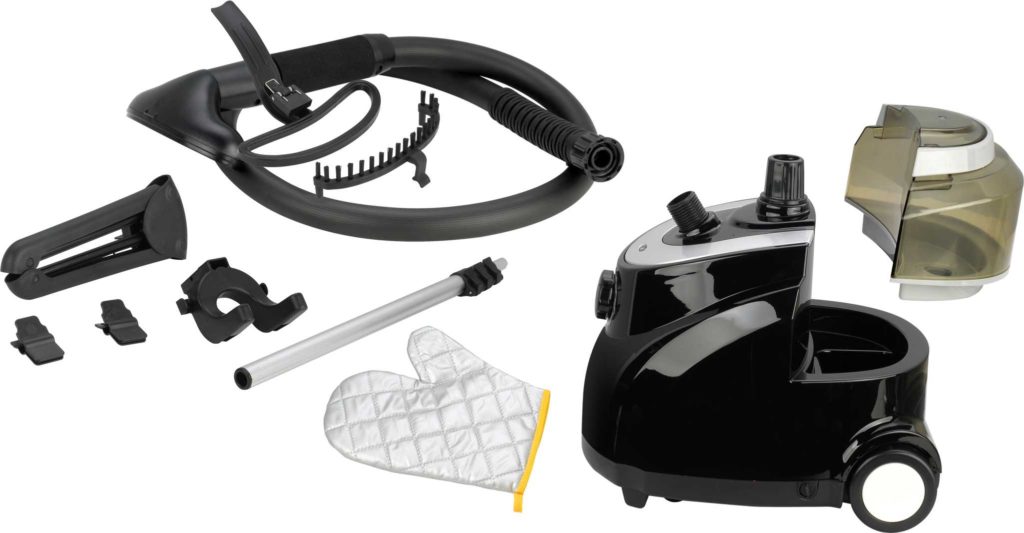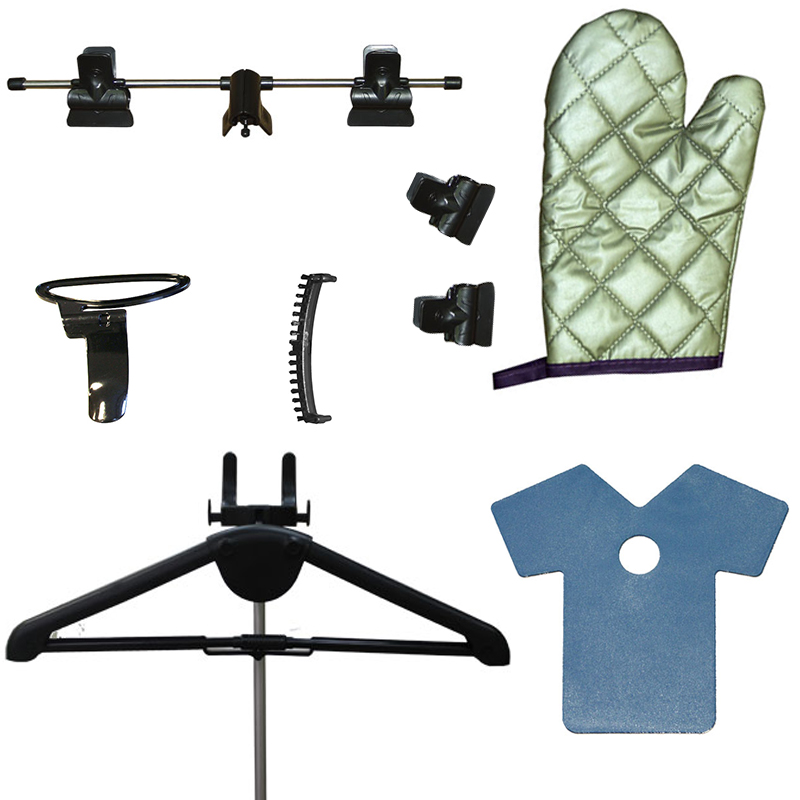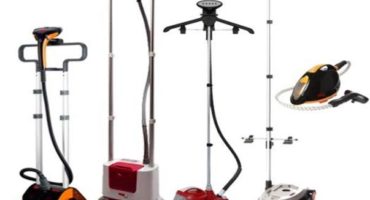In modern society, more and more different home appliances come to the aid of the hostess. At first glance, the steamer is not the device without which it is impossible to do. However, this is the opinion of those people who have not yet used it. Among the many modifications offered on the market, first of all you need to know - How to choose a steamer?
What is a steamer?
The functionality of the steamer is Ironing of clothes, curtains, curtains etc. (steam evens out the fibers of the fabric, clothes take on a neat appearance) by generating steam at a temperature of about 100 ° C. Very light, thin fabrics can be smoothed out with a steamer without touching the hot surface of the iron. But there is a universal steamer for the home, we will talk about it below.
Device device
In principle, the operation of the unit resembles an electric kettle. A tubular electric heater brings the water to a boiling point, and hot steam moves through the nozzle in the form of holes (as in the shower) or nozzle. The user conducts hot steam through hanging clothes, not being afraid to spoil a very delicate fabric and without leaving traces and wrinkles from internal seams if things are ironed.
For a general idea of the steamer, consider what nodes it consists of:
- A plastic boiler or boiler, into which usually purified water is poured (its volume can approximately vary from 1.5 l to 3.5 l).
- Tubular electric heater (TEN), heating water to steam.
- A small pump for supplying water to a hot heater (not installed on all models).
- A plastic sleeve connected to a steam generator through which steam flows.
- Nozzle for processing clothes (may be in the form of ironing made of metal or plastic).
- Folding rack with a clothes hanger.

What is a steamer for?
Many people will think why this device is needed, and if necessary, what type to choose, maybe do with a simple iron? Not always and not everywhere iron comes to the rescue. Surely you know the feeling when, at last, you have finished a long and painstaking job of ironing a blouse or dress with ruffles, patterns and other decorations or the upper part of men's shirts. The steamer will greatly simplify this process and the time spent on it.
To care for things from various materials, several types of steamers have been created, depending on the necessary operating conditions of the device:
- Handheld mobile steamers are a low-cost version of the device. Rather, they look like a brush for cleaning clothes or an electric kettle, but they will be very useful to a person who often travels and watches over his appearance.


The main advantage of these devices is their small overall dimensions and weight, ease of use, low cost. On some models, autonomous power may be used.
The operating time of the manual steamer is very limited (no more than 15-20 minutes), which allows you to process a couple or three things at a time, but on the way it will become an indispensable assistant.
- Vertical floor steamer. In low-cost models, the steam enters the nozzle on its own and, during the passage along the sleeve, manages to cool by 1-2 ° C. As a result, at the outlet it has a temperature slightly below 100 ° C.
Some types of these units have a built-in valve, due to which water vapor can be supplied under pressure for some time.This will help to handle heavy outerwear and wrinkled creases. By hanging an accessory from your wardrobe on a hanger, you can quickly steam it off.
This model works in a vertical position for 1.5-2 hours, depending on the volume of the boiler for water and the amount of its output for a certain time. It all depends on the technical characteristics of a particular model of steamer.
- Device with integrated pump or pump-action vertical steamer. This type of apparatus has a higher cost, but is more functional and faster in operation.

Here you do not need to wait long for the boiling of a large volume of water, since it is supplied in small portions to the hot heating element and immediately steam forms under a pressure of about 3 kgf / cm² (atm.), Regulated by a special sensor. This avoids overloading the boiler. The owner himself releases steam through the valve using the button on the nozzle.
This is a good steamer for working with heavy fabrics and a lot of clothes, due to the pressure and intensity of the steam jets, as well as the time of continuous use (as long as there is water in the tank). In addition to the ironing function, it can also remove unpleasant odors and small impurities on the fabric. Convenience in management and speed of work put it in a leading position in consumer reviews.
The only drawback of the device is its high cost. But for a large family, it will become an indispensable tool.
- Multifunctional combined units used both for ironing clothes and for cleaning certain surfaces. Usually, they come with many nozzles with the function of a steamer and a steam cleaner.

They can be either floor-mounted or hand-made, they work under pressure, combine a steam cleaner (for cleaning dirty surfaces) and a steamer. The disadvantage of this equipment is the high price and large volume of steam output.
How to choose a steamer
If you decide to purchase a steamer for home use, the question arises which of the many models is better? To select a specific device, you need to know by what criteria to implement it. Here are the main features for choosing the right model:
- Steam flow rate or intensity (shows how much heated water will be released per unit time). The average steam output in vertical steamers is 35-55 g / min, which corresponds to processing about one thing in 2 minutes. The feed rate in gravity steamers will depend on the capacity of the product. For equipment with forced pressure, this figure will be slightly higher - up to 70 g / min, of course, the processing time of clothes will be reduced by almost half. The biggest outlet is in multi-functional units with constant steam pressure, but they can moisturize clothes too much.
- Device power. This characteristic depends on the type of steamer and its dimensions. The unit can be low-power (up to 1 kW, usually with manual steamers), medium power (from 1.5 to 2 kW, often have gravity-fed vertical steamers) and powerful devices (over 2 kW - more expensive equipment). The speed of processing things in gravity and manual steamers will depend on the power indicator. For pumping devices, it is not so important, but it also matters.
- The volume of the boiler for water. For handheld devices, this characteristic ranges from 60 to 750 ml, and for the floor version - approximately 800 ml to 3.5 liters. This indicator is a double-edged sword. On the one hand, the larger the capacity, the longer you can continuously perform work. But on the other hand, a larger volume of water will take more time to heat up (in gravity products) and its weight is more. To process a large number of clothes at a time, it is better to have a boiler of 1.5 liters or more. This will be enough for steaming for 1 hour or more, but the steamer itself must withstand a sufficient working time.
- Clean water. This factor also plays an important role. When making a purchase in a store, it is imperative to pay attention to what water should be poured into the steamer for safe operation of the device. Some types of steamers can be operated by pouring plain tap water (more expensive, having special filters for water). Budget options usually require distillates or purified water to operate. Anyway, to prevent scale formation on the steamer, someday filters will require cleaning, and purified water will have to be purchased. With frequent use of the device, it is better to buy a steamer with the ability to work with plain water. There are models of steamers where water can be added without stopping operation.
- Nozzle material. A trifle, which many may not pay attention to, but the durability of the structure, the speed of heating, and the quality of steaming depend on it. In budget models, you can often find a nozzle made of plastic, with holes drilled in it. When processing products from fabric, condensation may form on it due to insufficient heating, and the clothes will get wet. Also, it is not durable in operation. The best option would be a nozzle made of metal or ceramic as it warms up faster. And if there is a function of heating the working plane of the nozzle, then this will be the best option for the steamer to buy.
- Modes of operation and their number. In this case, everything depends on the price of the product. The more expensive the unit, the more flexible it will be and have several steaming modes. Devices with several modes have a power regulator that changes the steam flow rate. This allows you to process various types of fabrics - heavy curtains and outerwear in intensive mode, and light silk and viscose in a more gentle mode. It all depends on how you steam, what clothes to process. You should not buy expensive equipment, then to use only one mode of operation and one function.
- What is included in the product package. It is worth paying attention to what devices are included with the steamer. They will help to process things more efficiently (a hanger in vertical models, a simple brush or with a clip for arrows on trousers, a clip for straightening trousers, a protective mitt worn on the hand when working with a steamer, a plane for steaming small parts of shirts). The rack for clothes in vertical units can be integral and folding. The latter will take up less space in the house.

To summarize: To care for clothes on the road or to give the suit a decent look before work, a handheld steamer is suitable. It does not take up much space in the house and its price is not high. For the care of light tulles, it is also suitable, since it is easier to reach the top of the curtain with a manual steamer.
If it is necessary to process all clothes, including the top, buy without hesitation a vertical steamer with a capacity of up to 2 kW and a steam feed rate of up to 45-55 g / min. People with limited living space can purchase multifunctional devices that will do the work of the steamer and steam generator.
Dear professional models are not worth buying for home use, they are more needed in stores and ateliers.
How to use a steamer
If you have made your choice and bought the right device, you need to assemble it and learn how to work with it correctly. Consider the preparation for operation on the example of a floor steamer:
- Assemble the components of the product (install the rack in the boiler body of the steamer, fix the nozzle for steam on it, tighten the steam sleeve with the body). For different models, the assembly is slightly different, follow the instructions for use.
- Collect cold water into a container and secure it in the boiler body.
- Unplug the power cord and plug it in.
- After the network indicator appears, you can turn on the steam supply with the button, holding the nozzle in the direction away from you (verification processing can be done on old things).
How to use the steamer while ironing
Working with the device is not difficult. When steaming, the nozzle must be moved from top to bottom. Horizontal movement and its inclination can lead to condensation.
During operation, use a mitten to protect against burns. Brushes and other devices will help to cope with work faster.
When all water from the tank is consumed, the device signals with sound. Before filling a new portion of water, you must turn off the power from the outlet (unless otherwise specified in the instructions).
After operation, the steamer must be allowed to cool and dry. The device requires periodic care and cleaning.



